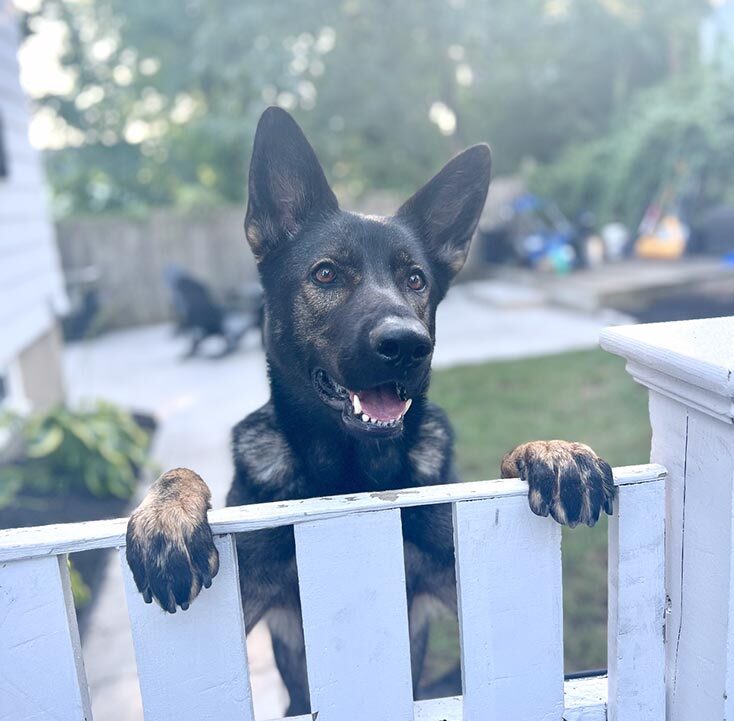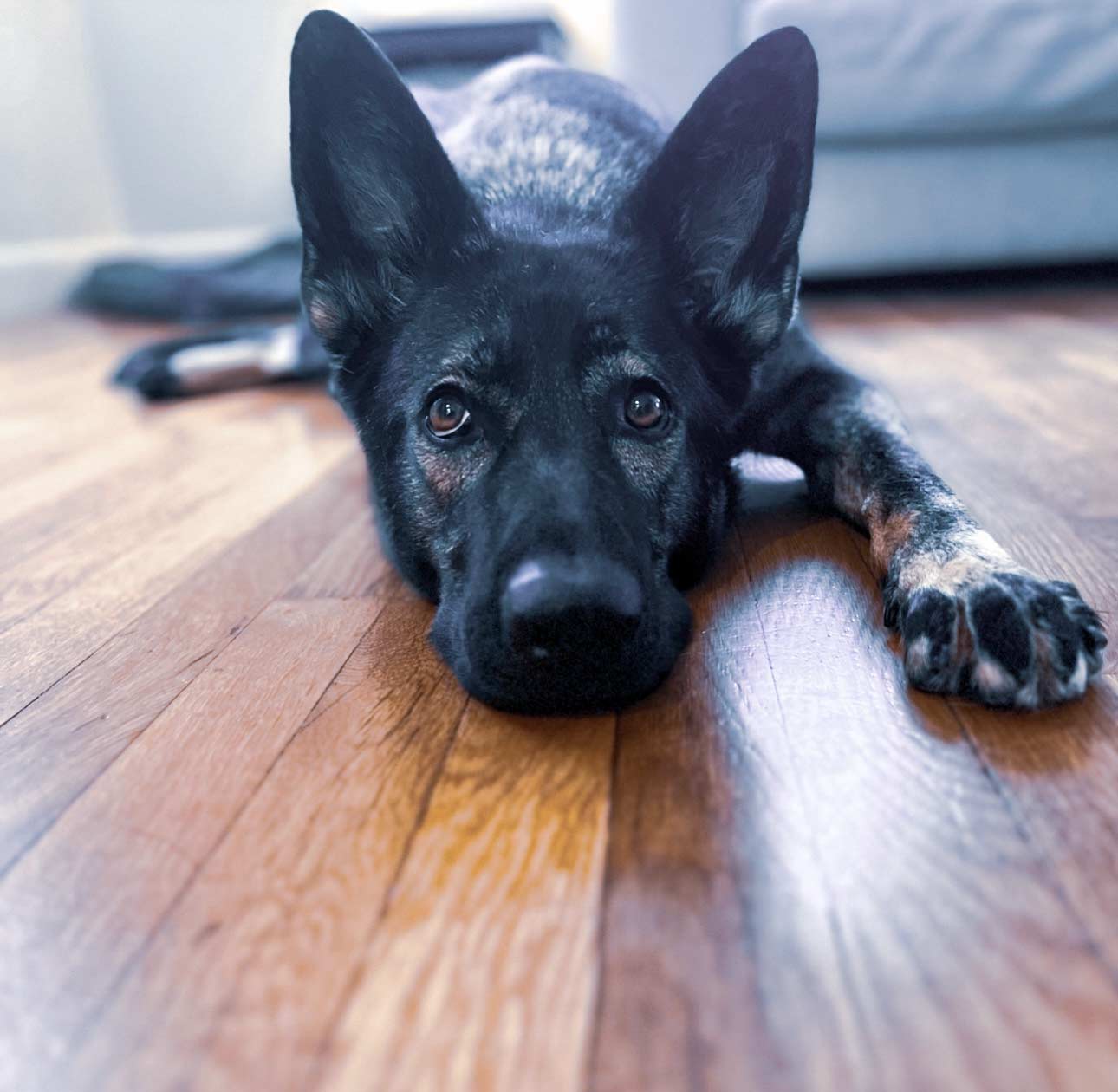I don’t think anyone actually warns new puppy parents how frustrating crate training can be. The good news is it’s actually really easy to get your puppy to love their crate. In this article, we will cover how to transform a regular dog crate into a safe space that your puppy loves.
You might look at a crate and think, “That looks like a puppy jail,” right? But hear me out—it’s actually more like a personal puppy chill zone. A crate isn’t just a safe area to keep your puppy out of trouble when you’re busy; it also gives them a comfy and safe spot to relax.
Think of it as your puppy’s semi-private bedroom, where they can nap, enjoy quiet time, or retreat when overwhelmed. Essentially, puppy crate training is like giving your dog a safety net, helping them feel secure and happy, no matter where they are.
In a hurry? Skim the Woof Notes below. If you’re here for the detailed nitty-gritty, keep reading.
Woof Notes
Choose the right crate size: Just big enough for standing, turning, and lying down.
Make it inviting: Soft bedding, chew toys, and maybe a crate cover for that cozy cave vibe. Remember to remove anything that could be a choking hazard if you are leaving your puppy at home in the crate.
Positive Association: Treats and praise make crate time a joy.
Place it where the action is: Let them feel part of the pack, even from their crate.
Routine is key: Stick to a schedule for crate, play, and bathroom breaks.
No punishment zone: The crate is a happy place, always.
With the right approach, crate training can be a walk in the park, and we’re here to guide you through it, one paw at a time.
Choosing The Right Puppy Crate
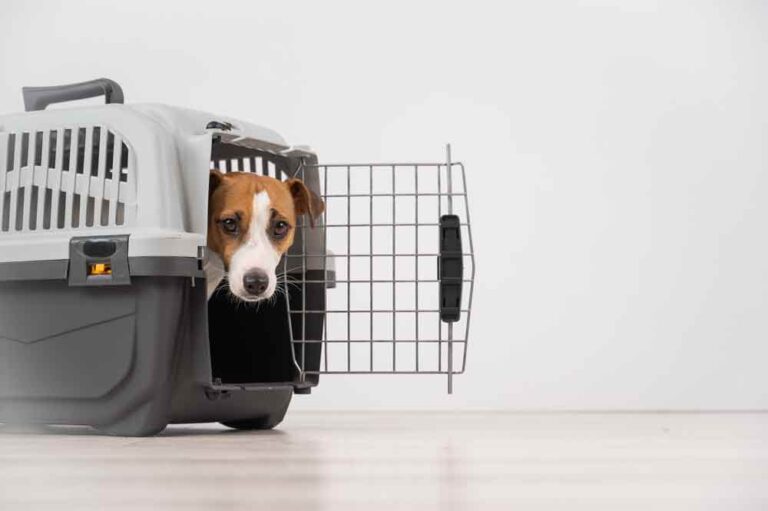
Size Matters: Choosing a dog crate is like choosing a room for your puppy; if it’s too small, they won’t be comfortable. Too big, and they might have the space to set up a bathroom in the corner.
You want to aim for a crate that’s cozy but not cramped. Your furry friend should have enough room to sprawl out, stand up, turn around, and stretch. If you have a breed that will get a lot bigger, look for a crate with dividers that can grow with them; that way, you don’t have to purchase multiple crates.
Material: Metal crates are sturdy and breathable. You and your puppy can see each other, which is excellent for check-ins and making your dog feel safe. Metal crates are usually foldable, making them easy to store and take on the go.
Plastic crates can also be cozy but are less durable and can feel a bit more enclosed, depending on which one you get. Metal is a better option if you have a breed that tends to chew.
Fabric crates are lightweight and portable, but they won’t stand up to chewers or escape artists.
Today, crates are sold at most pet supply stores and online. Before you purchase one, it’s helpful to read the reviews and see if you can find another dog owner with the same breed and size. Take a look at our free New Puppy Checklist to make sure you are ready to welcome your new furry friend.
Setting Up The Crate

Bedding: You want your puppy to look at their crate as a personal oasis, so make it comfy! A cushy, washable bed and a soft blanket that smells like you/your home can go a long way. It’s like having a piece of their favorite person with them. You want them to feel like they are part of the family, even when they are having some alone time or are away from home.
Toys: A couple of chew toys can make the crate more enjoyable for your dog, but just be wary of choking hazards. Water dishes are great for longer stints when you start leaving the house, but make sure they’re spill-proof to avoid a soggy mess when you return.
Crate Cover: Like wolves, dogs are den animals, and many prefer the cave-like feel and security that a crate cover provides. But before spending money on a crate cover, use a blanket or a sheet to experiment. Maybe your puppy wants to keep an eye on their surroundings so they only like their crate partially covered. Test and learn to find out what your dog likes.
Location, Location, Location: Finding the right location when you are crate training is like picking the hotel room with the best view. You want it in a social spot where your dog can see and feel part of the family action without being in the middle of the foot traffic. Your puppy wants to be where you are, even when they’re in their crate.
Think about where your family spends most of their time and try to find a quiet spot there. Avoid too much isolation, though; you don’t want your pup to feel exiled. A quiet corner in the family room lets them observe the family buzz without getting overstimulated.
With the proper setup, your pup’s crate can become their favorite spot in the house, where they’re always happy to hang out.
Helpful Tip: Moving the crate at night so that your puppy can be closer to you can significantly reduce whining, barking, and sleepless nights. More on that below.
Create Positive Associations
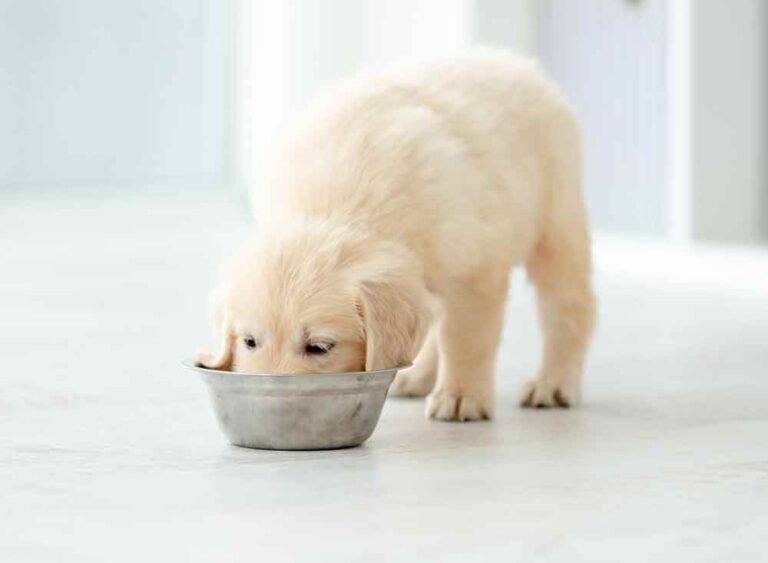
First Impressions: Introduce the crate with happy vibes and lots of treats. After you finish setting up, leave the crate door open and let your puppy sniff around. Sit quietly near the crate and keep things low-key; just let them check out the new spot. Place treats leading towards and inside the crate. Offer lots of praise and excitement when your dog enters the crate.
Make It Rain Treats (Literally): Once your pup is comfortable enough to snatch up the snacks inside the crate, continue tossing treats inside while your pup watches you. The goal is to convince them that getting inside this crate is the best decision they’ve ever made and create a pleasant association using their favorite treats.
Dining In: Begin feeding your dog in their crate to reinforce it as a positive space. If they associate the crate with their favorite food, they are more likely to want to spend time there. Start by placing their food dish in the crate with the door open, and as they get more comfortable, gently close the crate door while they eat. If they finish their meal and seem content, leave them in there for a few minutes longer, gradually increasing the crate time.
Incremental Crate Time: Start with short periods of crate time and gradually increase. As they get more comfortable, begin leaving the house for short durations. According to Brittany Grenus at Tufts Cumming Veterinary Medicine, once your pup can relax quietly in their crate for 30 minutes, you can start leaving them alone for short periods. Make sure to leave quietly and then return without making a big entrance. If your puppy is doing well, gradually leave for longer periods.
This helps teach your dog that it’s okay when you leave because you always come back. This builds trust and shows them that the crate is a safe space, even when you’re not around.
Safety Tip: Never leave your dog unsupervised while wearing a collar or a leash as they can become strangling hazards.
Build A Routine
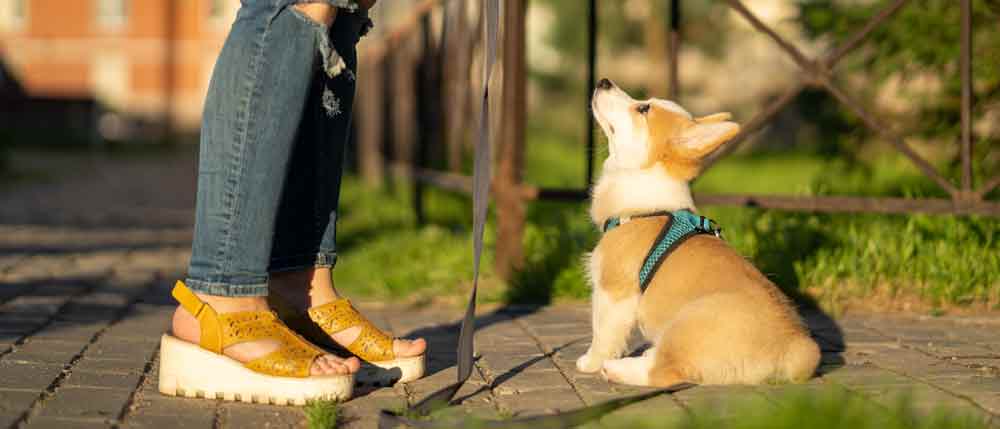
Incorporating the crate training process into your puppy’s daily life is like weaving a thread of security and comfort through their routine. It’s about making the crate a regular, positive part of their day, not just a place they visit occasionally.
Daily Routines: Dogs thrive on routine. A daily schedule that includes crate time helps your puppy know what to expect, reduces anxiety, and builds trust and confidence. Your puppy’s schedule should include a healthy mix of walks, playtime, meals, and quiet crate time. Scheduling crate time after playtime and meals will encourage your puppy to rest. This routine helps your puppy learn that the crate is a relaxing space.
Nighttime Rituals: Even if you plan to let your dog sleep in your bed, teaching them to sleep in their crate overnight can come in handy. If someone else has to watch your pup or if you travel somewhere where the dog can’t sleep on the furniture, having a dog that is comfortable in their crate goes a long way. Keeping your dog crated at night also prevents them from roaming the house and getting into trouble while you are asleep.
Keeping the crate near you at night can ease your dog’s worry. Place the crate in your bedroom or a quiet area where they can hear and smell you. This will lessen their anxiety and strengthen your bond. If your crate is inexpensive, you might consider having one in both the living area and the bedroom instead of moving it each night. Using a comfort toy, like the Snuggle Puppy Heartbeat Toy can help ease your puppy’s anxiety.
Our dog slept in her crate at night as a puppy in the next room. Now, she has a dog bed in our bedroom, but sometimes she chooses to sleep in her crate, which is still in the next room. Although we are bummed when she’s not in the room with us, it’s nice to know that she has a place where she feels secure on her own.
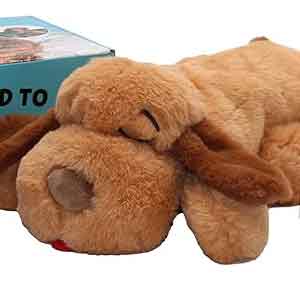
Snuggle Puppy Heartbeat Toy
- Recreates Maternal Intimacy
- "Real-Feel" Pulsing Heartbeat
- Batteries & Heat pack Included
- Machine Washable
Socialization and Crate Placement: Having the crate in a living area where your puppy can observe daily life helps with socialization. They learn about the sights, sounds, and rhythms of the household from the security of their crate. This exposure is crucial for their development and helps them become well-adjusted adults. Maintaining a balanced schedule that includes quiet time in the crate will help your puppy learn to relax independently within the family dynamic.
Common Crate Training Challenges and Solutions

Dealing with Whining and Barking: When your dog whines and cries, it can tug at your heartstrings and test your patience. I know it’s tough not to let them out of the crate when they cry, but giving in teaches them that noise works. Rewarding their noise with attention teaches the wrong lesson.
Frequent check-ins to make sure they don’t genuinely need a bathroom break go a long way. If your dog needs a potty break during crate time, take them outside swiftly. Keep everything strictly business; no playing or dilly-dallying in the yard. Bring them back to the crate as soon as they are done. Dogs are intelligent animals – if you let them hang around and start to play, they will learn that faking a bathroom break will get them out of the crate.
Accidents in the Crate: Accidents happen during crate training, especially in the early days. Make sure the crate isn’t too big. Dogs tend to avoid soiling their sleeping area, but if there is too much room, they might use a corner as their bathroom. Ensure they have plenty of potty breaks to minimize mishaps.
Puppies under 6 months old don’t have complete control of their bladders or bowels yet and should never be in the crate for more than 3 or 4 hours at a time.
Helpful Potty Training Tip: It’s good to keep an enzymatic cleaner on hand to wipe all traces of the accidents away, discouraging them from going in the same spot again. Because dogs have incredible noses, regular household cleaners don’t completely eliminate what they can smell. Dogs will tend to go to the bathroom in the same areas, where they smell old traces of their pee and poop.
Separation Anxiety: Watch for signs. For many puppies, being alone feels like the end of the world. They will probably cry when you first start leaving them alone, and this is totally normal. Puppies without separation anxiety will settle down on their own, whereas dogs with separation anxiety will continue crying until you return. Other unhealthy signs of separation anxiety include shaking, stomach upsets, drooling, and pacing.
Patience and consistency during crate training can help ease your puppy’s worry about being left in the crate. Start crate training in short periods and gradually increase the time. This teaches your dog that the crate isn’t permanent. Keep your arrivals and departures quick and low-key; don’t make a big deal out of them. If your puppy is still upset, try leaving a radio on or using a white noise machine to help soothe them.
Refusal To Enter The Crate: Sometimes, despite your best efforts, a puppy may still resist entering their crate. First, make sure the crate is inviting and comfortable. Is the bedding soft? How is the temperature? Is it too cold? Too hot? Is it near an air vent? Are there any scary noises nearby, like a radiator?
Take a step back in training. Use a lot of treats to make it a game for your puppy by having them enter without closing the door. Do this daily until they are comfortable getting inside the crate. Gradually work up to short, closed-door sessions filled with more treats and praise.
Keep the experience positive, and always avoid using the crate as punishment. Consistency and patience in your approach will eventually turn the tide.
Conclusion
Successful crate training isn’t just about picking a box; it’s about understanding your dog’s needs and giving them their own space to feel safe and secure. Remember, every dog is unique, and what works for one may not work for another.
Be patient and flexible, willing to adjust your approach as you learn more about your puppy’s preferences and personality. As pet parents, we need to remember to celebrate small victories, like the first time they go into the crate on their own or sleep through half of the night without waking you up.
With patience and consistency, the crate will quickly become a safe place where your puppy feels comfortable and content, whether you are there or not. By incorporating these practices into your daily life, the crate becomes more than just a piece of furniture; it’s a home within a home for your furry best friend.


